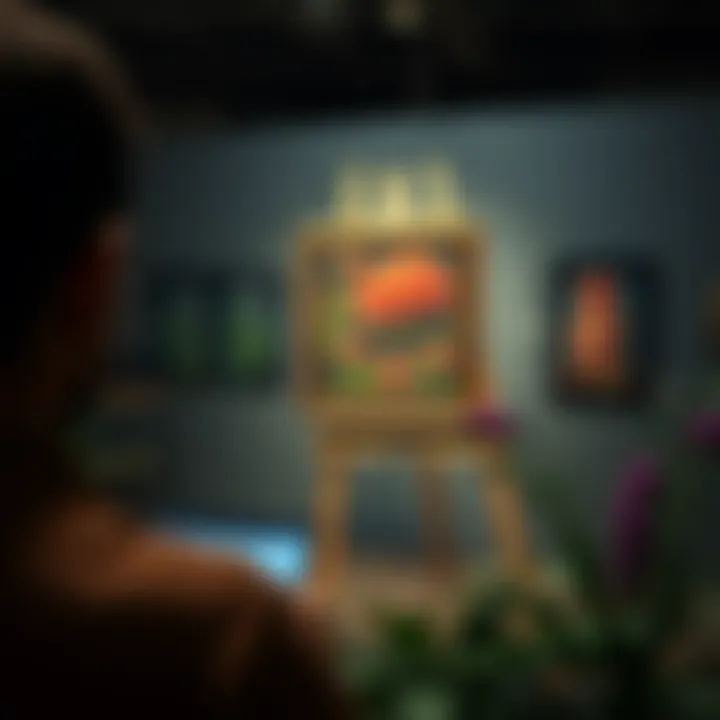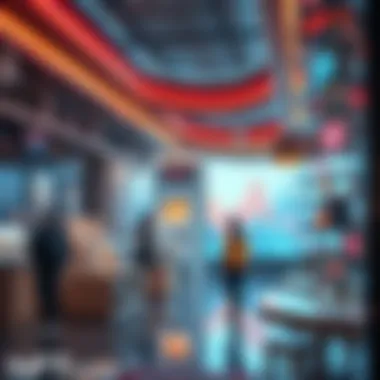Exploring the NFT Online Gallery Landscape: Art Revolution


Intro
The realm of art has undergone a seismic shift in recent years with the advent of digital technology, leading to the rise of NFT online galleries. These platforms play a crucial role in this transformation, providing artists and collectors a unique avenue to engage with digital art. Catching the attention of investors, traders, and tech enthusiasts alike, NFTs are reshaping how art is perceived, valued, and traded in the digital economy.
To appreciate the significance of NFT online galleries, we first need to explore their foundations. Understanding the principles of cryptocurrency and blockchain technology is essential, as they are the backbone of NFTs. Without this knowledge, it’s challenging to grasp how these digital assets work or why they are becoming so valuable in today’s marketplace.
In this article, we will break down the complexities while illuminating the pathways through which NFT galleries flourish. From grasping core concepts to analyzing market trends and predictions, our objective is to offer you, the reader, a detailed understanding and a head start in navigating this exciting new landscape.
Foreword to NFTs and Online Galleries
In the vibrant tapestry of digital art, NFTs (Non-Fungible Tokens) have emerged as a groundbreaking phenomenon. They offer a unique approach to ownership and provenance of digital assets. Understanding NFTs and their interplay with online galleries is crucial for anyone navigating this evolving landscape. This article delves into the intricate details surrounding NFTs and online galleries, shedding light on their significance, benefits, and the considerations one must keep in mind.
Defining NFTs and Their Rise
NFTs essentially create a digital certificate of authenticity for a specific item, whether it’s art, music, or even tweets. Unlike cryptocurrencies like Bitcoin, which are interchangeable, NFTs represent unique items. They enable artists to tokenize their work, allowing creators to have more control over their intellectual property. The rise of NFTs can be traced back to a perfect storm of technological advancements—blockchain technology, social media traction, and a growing appreciation for digital creations. Digital artists, who once struggled to monetize their work, now find themselves at the forefront of an art revolution. Transactions have skyrocketed, with sales reaching staggering amounts, attracting not only collectors but investors as well.
For example, digital artist Beeple created a digital piece titled "Everydays: The First 5000 Days," which sold for a jaw-dropping $69 million at auction house Christie’s. This sale put a spotlight on NFTs, prompting discussions around their future as a valid art form. It’s a clear indication that this rise isn't just a flash in the pan; it represents a transformative shift in how art is perceived and traded.
With newfound avenues to connect with audiences, artists are gaining a louder voice in an industry historically dominated by traditional gatekeepers.
What Constitutes an Online Gallery?
An online gallery is much like a traditional art gallery but exists in the digital realm. These platforms allow artists to showcase and sell their work without the constraints of physical spaces. Key characteristics include:
- Interactivity: Many platforms offer immersive environments where users can walk through virtual galleries.
- Accessibility: Geographically, anyone with an internet connection gains access to artworks from around the world.
- NFT Marketplace Integration: Online galleries often have features to directly purchase or bid on NFTs, streamlining the buying process.
- Artist Empowerment: Many of these platforms prioritize artist mentorship and community building, fostering an ecosystem for growth.
Some of the prominent online galleries today include OpenSea, Rarible, and Foundation. Each offers unique features, from community-driven sales to curated exhibitions, making the digital art world more inclusive. The emphasis on user experience paired with diverse art shows how online galleries play a pivotal role in changing the dynamics of art transactions and ownership.
Online galleries represent a shift toward democratized art, where barriers are reduced, and artists thrive regardless of their location or connections.
The Technological Backbone of NFT Galleries
NFT galleries wouldn’t exist without the advancements in technology backing them. This section will delve into the crucial elements, benefits, and considerations of the technologies that power NFT galleries, highlighting how those factors contribute to their significance in the digital art landscape.
Blockchain Technology and Its Importance
At the heart of NFT galleries lies blockchain technology. It serves as the secure foundation on which these digital assets rest. Blockchain is a decentralized ledger that records transactions across many computers, ensuring that records cannot be altered retroactively. This is vital for NFTs, as each transaction must be permanent and traceable.
- Decentralization: Unlike traditional systems where a central authority might control records, blockchain allows for distributed control. This minimizes risks associated with single points of failure, providing greater security and reliability.
- Transparency: When artists mint their digital art as NFTs on a blockchain, it creates a public record of ownership. Collectors can verify the history of a piece, ensuring they’re doing business with integrity.
- Security: The cryptographic principles used in blockchain technology mean that unauthorized access is virtually impossible. For collectors and investors, this aspect can be a major reassurance as they navigate often expensive transactions.
- Interoperability: Different NFT marketplaces utilize various blockchain ecosystems, such as Ethereum, Solana, and Tezos. This variability means collectors have the flexibility to trade across platforms, expanding their buying and selling options, which is often more nimble than conventional art galleries.
"The rise of blockchain technology is not just a trend; it's reshaping how we perceive ownership and authenticity in a digital era."
These features collectively make blockchain integral not just for security, but for the very functioning of NFT online galleries. The world of digital artistry can feel vast and, at times, intimidating, but blockchain provides a framework that gives participants confidence.
Smart Contracts: Ensuring Authenticity and Ownership
Smart contracts are an evolved form of agreements that automatically execute actions based on pre-defined conditions, and they are immensely significant in the NFT space. Smart contracts outline the terms of the asset sale, guaranteeing that artists receive compensation whenever their work is resold. This built-in advantage ensures a fair compensation model that often eludes traditional art markets.
- Benefits of Automation: The automation of transactions means that there’s less room for human error. Both artists and buyers can focus on the art rather than being bogged down in negotiation webs.
- Royalty Payments: One of the most talked-about features is the ability to program royalties into the contract. This guarantees that artists earn a percentage of future sales, fostering an ongoing relationship between creators and their work.
- Conflict Resolution: Smart contracts reduce disputes over ownership. Since the terms are coded and unchangeable once deployed, it minimizes (or even eliminates) conflicts regarding authenticity.
- Accessibility and Lower Costs: Unlike traditional contracts which often require legal oversight, smart contracts streamline agreements, making them accessible to anyone, regardless of their knowledge of legal jargon. This democratization of art transactions contrasts with the elitism often found in physical art galleries.
The implications of smart contracts in NFT galleries can’t be understated. They empower artists and collectors alike, creating a robust ecosystem in which art can thrive without the conventional gatekeeping often found in the traditional art world.
By understanding the technical underpinnings of NFT galleries, stakeholders can better navigate this increasingly complex landscape. As we continue our exploration into trends and artistry within this domain, recognizing the backbone provided by blockchain and smart contracts is essential for grasping the future of digital art.
Current Trends in NFT Online Galleries


The world of NFT online galleries is constantly shifting, akin to a river that never stops flowing. Current trends not only reflect the evolving nature of digital art but also shed light on how artists and collectors interact within this new paradigm. At the heart of this exploration are various emerging platforms and the novel interactive experiences they offer, both of which are reshaping the digital realm where art and commerce meet.
Emerging Platforms
In recent times, platforms dedicated to NFTs have sprouted like wildflowers in spring. Some notable examples include OpenSea, Rarible, and Foundation. These platforms provide artists with the means to showcase their work and collectors with a space to acquire unique pieces.
Impact on Artists and Collectors
- Accessibility: Artists from all walks of life now have the capability to reach global audiences, something nearly impossible in traditional galleries.
- Diverse Revenue Streams: With the rise of emerging platforms, creators can earn not only from initial sales but also receive royalties every time their work is resold, an option not available in conventional art markets.
- Community Engagement: Many of these platforms foster vibrant communities, allowing creators and collectors to interact, collaborate, and promote each other’s work.
By leveraging blockchain technology, these platforms not only ensure transparency in transactions but also provide a secure method to validate ownership and authenticity. The community aspect of these platforms changes the game, making art a shared endeavor rather than a solitary pursuit.
Interactive and Immersive Experiences
As we venture deeper into the digital age, interactive and immersive experiences are taking center stage within NFT galleries. Gone are the days when viewing art simply meant standing in front of a painting. Now, it’s about engaging with the art in ways that invoke emotions and provoke thoughts.
- Virtual Reality Exhibitions: Artists are developing virtual galleries where visitors can explore in a 3D space, creating a sense of presence that traditional formats can’t match. For instance, a viewer can walk through a digital gallery from the comfort of their living room, connecting with art in a more intimate manner.
- Augmented Reality Features: Some NFTs come with AR capabilities that allow buyers to project artwork onto their physical environment. This fusion of the digital with the physical elevates the experience, inviting collectors not just to own art but to live with it.
"The ability to engage with art in a participatory manner adds layers of meaning that traditional displays rarely achieve."
Overall, these developments signify a movement away from passive consumption toward active interaction. Artists are not just creating works to be viewed; they are crafting experiences that invite viewers to become participants in the art itself.
These trends indicate a burgeoning landscape where technology, creativity, and commerce converge, creating an unparalleled opportunity for both artists and collectors. As the boundaries blur between art and technology, one can only marvel at what lies ahead in the world of NFT galleries.
The Role of Artists in NFT Galleries
The transformation of the art world has been monumental over the past few years, particularly with the emergence of NFT galleries. At the forefront of this change are artists, who harness technology to redefine not just how they create, but also how they connect with their audience. The role of artists in NFT galleries is crucial, as they play a fundamental part in shaping these digital landscapes.
Creating Digital Art for NFTs
Creating digital art specifically for NFTs involves more than merely taking existing pieces and converting them into tokens. Artists must consider several elements when crafting their work. For one, originality is key; given the vast array of digital content available online, standing out can be a tall order. Artists need to explore innovative styles, techniques, and concepts to catch the discerning eyes of collectors.
The medium itself is flexible, with options ranging from animations to static images, and even generative art, where algorithms contribute to the creation process. Platforms such as OpenSea or Rarible allow artists to mint their works as NFTs, giving them a unique identity on the blockchain. However, artists must also navigate the technical aspects of this process, determining file formats, resolution, and visibility options that best showcase their art.
Monetization Strategies for Artists
Monetizing art through NFTs opens up a myriad of opportunities, yet it also presents challenges that artists need to grapple with. Traditional art markets often favor established names, but in the realm of NFTs, newcomers may find success if they employ strategic approaches.
Some effective monetization strategies include:
- Royalties: Many platforms allow artists to earn a percentage on secondary sales, giving them a continuous revenue stream.
- Limited Editions: Artists can create exclusive pieces, generating scarcity that can increase demand and value.
- Collaborations: Teaming up with other artists or brands can broaden exposure and create unique works that attract attention.
- Community Engagement: Building a loyal fanbase through social media platforms can lead to increased sales as followers may seek to own a piece from their favorite artists.
However, it’s essential for artists to remain grounded and realistic about their expectations. The NFT space can be volatile, and what’s trendy today may fade tomorrow.
Building Personal Branding in the Digital Sphere
In an environment saturated with creators, carving out a personal brand is pivotal for artists venturing into NFT galleries. Personal branding goes beyond aesthetics; it encapsulates the artist's vision, style, and philosophy. A strong brand can distinguish one’s work and draw in collectors.
To build a brand, artists should consider the following aspects:
- Consistent Visual Language: Maintaining a particular style in their creations can help reinforce recognition among audiences.
- Storytelling: Sharing the narrative behind each piece enhances emotional connections with potential buyers. The narrative adds depth and context, making the artwork more appealing.
- Utilizing Social Media: Platforms like Instagram and Twitter are crucial for artists to share their work and engage with collectors. Regular updates on the creation process and personal insights can captivate and expand an audience.
- Professional Presence: Maintaining a well-designed portfolio or website can strengthen credibility and serve as a central hub for their work.
"In this experience-driven economy, it's not just about the art; it's about the story and the engagement behind it."
As artists navigate the NFT gallery landscape, understanding their role and implementing effective strategies can not only amplify their work but also reshape their future in this evolving domain.


Impact on Collectors and Investors
The rise of NFT galleries has sparked significant interest among collectors and investors, intertwining their fates with a rapidly evolving digital landscape. This section will explore how NFTs have changed the way collectibles are perceived, their inherent value, and the investment strategies adopted by many. Understanding this shift is paramount for anyone looking to navigate this dynamic environment, as it affects strategies, opportunities, and risks alike.
Acquisition and Valuation of NFTs
Acquiring NFTs is not just about purchasing digital assets but involves a deeper understanding of their valuation. Unlike traditional art, which often relies on provenance and artist reputation, the valuation of NFTs can hinge on multiple factors, including rarity, market trends, and the utility offered by the token. The minting process leaves a digital footprint that indicates authenticity, which can play a pivotal role in pricing.
- Rarity: The scarcer a piece is, the higher its demand. Unique works often command premium prices simply because collectors desire exclusivity.
- Market Trends: As trends fluctuate, so do the values of NFTs. A piece that was once in high demand may lose its luster, reflecting the volatile nature of the digital marketplace.
- Utility: Some NFTs offer tangible benefits beyond mere ownership, such as access to exclusive events or digital experiences. These additional perks can significantly affect their valuation.
The process of acquisition can be straightforward but requires diligence. Platforms like OpenSea or Rarible allow users to buy, sell, and discover NFTs, but due caution is necessary. Evaluating the authenticity and condition of the NFT should always come first.
To equip yourself for this journey, it’s beneficial to follow prominent digital artists and platforms. Understanding their impact on market dynamics can save investors from pitfalls. Drawing insights from various sources, including Wikipedia and Reddit, can also facilitate informed decision-making.
Navigating Market Volatility
The NFT market has proven to be a rollercoaster ride, pulling investors in and out of situations faster than one can imagine. Navigating this volatility requires not just a sturdy heart but also a strategic mindset. Investors must recognize that the market can swing wildly based on speculation, media coverage, and even macroeconomic factors.
- Fluctuating Prices: Unlike stocks or bonds, NFT prices can experience dramatic shifts overnight. Investors should watch for signals in market trends to make educated buying or selling choices.
- Emotional Decisions: The blend of art and finance can lead emotions to run high. It's essential to be cautious of FOMO (Fear Of Missing Out) as it often drives impulsive actions.
- Research and Network: Engaging with communities on platforms like Discord or Telegram can provide real-time insights and market sentiment, enriching one's understanding of trends.
"The only thing certain in the NFT world is uncertainty."
Investors who wish to succeed must blend intuition with sound analysis. An understanding that not every NFT will appreciate can help curb unrealistic expectations, emphasizing the importance of patience and long-term commitment among collectors.
As the landscape continues to evolve, those who adapt and remain informed about market shifts will likely thrive. In this uncharted territory of digital assets, keeping an eye on fluctuations and making strategic decisions based on data can enhance the chances of success for collectors and investors alike.
Legal Considerations in NFT Galleries
The world of NFTs is not just a haven for artists and collectors; it also opens a Pandora's box of legal considerations. This section aims to highlight the legal landscape that surrounds NFT online galleries, underscoring the significance of intellectual property rights and regulatory challenges faced by these platforms. The legal frameworks that govern digital assets are evolving, necessitating a vigilant comprehension of these issues for both creators and buyers in the NFT arena.
Intellectual Property Rights in the Digital Age
When discussing NFTs, the matter of intellectual property rights cannot be swept under the rug. Often, artists wonder about the legal backing of their digital creations when they tokenize their works as NFTs. Intellectual property rights give creators more than just a sense of ownership; they offer protection against unauthorized use of their creations. In the realms of art, copyrights play a crucial role.
For instance, if an artist produces a digital painting and mints it as an NFT, they still hold copyright over the original piece unless they explicitly transfer those rights to a buyer. Buyers should be clear on the rights they acquire upon purchasing an NFT—whether it’s just access, exhibition rights, or the ability to reproduce the artwork. Understanding the distinct types of rights in this digital context is paramount.
"Copyright law provides a framework that can support artists' rights in this new digital marketplace, safeguarding creativity while dealing with the complexities of ownership."
This legal consideration extends further; as the lines blur between traditional art and digital art, legislation needs to keep pace. Artists should seek clarity in their contracts and consider consulting with legal experts to avoid any pitfalls. It's crucial to document agreements meticulously to ensure that all parties understand their rights, thus preventing potential disputes down the line.
Regulatory Challenges Facing NFT Platforms
As the NFT market continues to burgeon, regulatory challenges are surfacing like bread rising in the oven. Governments worldwide are scrambling to understand how to regulate this new form of asset. One fundamental challenge is the classification of NFTs. Are they collectibles, securities, or digital assets? The answer varies by jurisdiction, and this ambiguity can create turmoil for both buyers and sellers.
Many platforms face scrutiny regarding compliance with existing laws, such as anti-money laundering (AML) and know-your-customer (KYC) regulations. If a platform doesn’t adhere to these requirements, it risks fines or, worse, being shut down. Adopting a proactive stance toward regulation not only cultivates trust in the market but also protects a platform from potential legal ramifications.
Additionally, issues such as geographical limitations and differing tax obligations can turn into a veritable minefield for NFT projects. Different countries may impose varying regulations on digital assets that can affect the accessibility of NFT marketplaces for investors. This web of laws complicates the landscape considerably, making it essential for platforms to stay informed about the legal environment they operate in.
In summary, being versed in the legal considerations of NFT galleries is pivotal for all participants—be it artists, investors, or curators. The bounds of intellectual property and the shadows of regulatory scrutiny must be navigated with care to ensure the sustainability and integrity of the NFT ecosystem.
Environmental Considerations of NFTs
The interplay between NFTs and environmental sustainability is increasingly coming under the limelight. As the digital art space burgeons, so do concerns surrounding the carbon footprint of blockchain technology, which serves as the backbone for cryptocurrencies and NFTs. Engaging with these environmental considerations is pivotal not just for artists and collectors, but for the integrity of the entire ecosystem.
Energy Consumption of Blockchain Networks


Blockchain technology, essential for NFTs, operates on a model that requires immense energy to validate transactions. The proof-of-work mechanism, utilized by prominent blockchains like Bitcoin, consumes more energy than some countries. An estimated 77 terawatt-hours were used in a single year by the Bitcoin network alone. This raises valid concerns about sustainability, as the energy used often relies on non-renewable sources, exacerbating climate change.
"The environmental implications of blockchain technologies are vast and cannot be overlooked, especially in a world increasingly leaning towards greener solutions."
In contrast, Ethereum is transitioning from the proof-of-work to a proof-of-stake model, significantly reducing its carbon footprint. This shift underscores the ongoing discussions around energy usage and the need for cleaner alternatives in the NFT space. Activists and environmental advocates highlight the necessity for platforms to minimize energy consumption, advocating for transparency regarding the energy sources used.
The Search for Sustainable Alternatives
The hunt for eco-friendlier blockchain solutions is on the rise, as innovators explore alternative technologies. One promising approach is the implementation of layer-two solutions such as Polygon or Ethereum 2.0, which enhance transaction speed and scalability while lowering energy needs.
Another alternative involves the integration of renewable energy sources. Projects that harness solar or wind power to fuel their blockchain operations propose a practical path forward. This dual-focus approach not only enhances the sustainability of NFTs but also responds positively to the growing demand from consumers who prefer environmentally responsible options.
Moreover, several platforms are making efforts to offset their carbon footprints. For instance, initiatives like "Art for Nature" leverage art sales to fund tree planting and environmental restoration projects. This method effectively marries environmental responsibility with artistic expression, showing that the NFT community is capable of providing solutions rather than just adding to the problem.
Engaging with these alternatives, both the artists and the collectors can contribute to a greener digital landscape. The goals are twofold: to promote innovation in technology that supports sustainability, and to cultivate a culture among NFT enthusiasts that values ecological responsibility. In an era increasingly driven by climate consciousness, tackling environmental considerations is not just an obligation; it is a pathway to future success in the NFT marketplace.
For more information on energy consumption of blockchain networks, you can check out Wikipedia on Blockchain Technology or visit Britannica.
As the digital art world expands, these environmental considerations must position themselves at the forefront of dialogue, shaping policies and practices that ensure a sustainable, vibrant future.
Future Prospects of NFT Online Galleries
Looking ahead at the NFT online galleries, we stand on the precipice of transformation. These digital spaces are not just a fleeting fad; they’re paving the way for how art is created, shared, and valued. As the ecosystem matures, understanding its trajectory becomes essential for artists, collectors, and investors alike.
NFT galleries offer a unique opportunity for artists to present their work in a manner that bypasses traditional gatekeepers. The advantages are many, but couple it with the fact that digital art can be fluid and ever-evolving, and you have a canvas that adapts to the times while retaining its originality. This ability to update the work and provide deeper engagement with art collectors is transformative.
In the world of investments, the rise of NFT galleries signifies a shift in asset management strategies. Collectors are now looking beyond mere ownership; they are interested in participation. The focus is on immersive experiences that foster community.
Evolving User Experiences
The user experience in NFT galleries is evolving faster than the changes in a chameleon’s colors. Initially, viewing a piece and making a purchase seemed straightforward. However, as these platforms develop, they will likely embrace more interactive features. Imagine attending a virtual exhibition where you can not only view but also engage with the art through augmented reality, making you feel as if you are part of the artwork itself.
- Personalized Galleries: Users will soon have the option to create customized gallery spaces that reflect their tastes and interests, making the browsing experience much more engaging.
- Community Integration: Social features will play a significant role; expect options for commenting, sharing, and creating discussions around pieces, which will deepen the connection between artists and collectors.
- Dynamic Display Methods: The use of VR and AR might allow users to visualize artwork in real-life contexts, letting them see how a digital piece would look in their living room.
In essence, the user experience is being tailored towards creating a more interactive and community-driven platform. This continual adaptation will not only attract more users but will also enhance the appreciation of digital art.
Integration with Traditional Art Markets
While NFT galleries are revolutionizing the way we understand art, the dialogue between digital and traditional markets is becoming increasingly important. Traditional art dealers are starting to realize the potential that digital art offers, and many are cautiously integrating NFT strategies into their business models.
- Hybrid Exhibitions: Expect to see exhibitions where traditional artists are showcasing both physical pieces and their digital counterparts side by side.
- Auction Houses Adapting: Established auction houses like Sotheby’s and Christie’s are beginning to offer digital art at auction, signaling a growing legitimacy and acceptance of NFTs in the fine art domain.
- Collaborations and Collectibles: Partnerships between NFT marketplaces and traditional galleries are likely to increase. Imagine a candlelit gallery where paintings share walls with digital screens displaying interactive NFT art to draw in a diverse audience.
Integrating these two worlds is not without challenges, particularly around valuation and authenticity. But as both markets begin to coexist, we see a blending of aesthetics and audience demographics that could redefine what constitutes art itself.
"As artists and collectors forge paths through digital landscapes, the blurred lines between traditional media and burgeoning forms redefine our understanding of ownership and artistry."
The future of NFT gallery spaces holds promise, enhanced by a continual evolution of user experiences and a budding relationship with traditional art markets. Both challenges and opportunities lie ahead, creating a landscape rich for exploration.
The End
As we look back at the journey through NFT online galleries, it’s evident that their significance transcends mere trends in digital art. These spaces are not just about showcasing art; they represent a paradigm shift in how creators, collectors, and investors interact with art in the digital realm. It's like reinventing the wheel for the art world, allowing it to roll with the times while kicking up dust in previously uncharted territories.
Summarizing the Impact of NFT Galleries
The impact of NFT galleries is profound and multi-faceted. Here are some key takeaways that demonstrate their relevance:
- Access and Inclusion: Unlike traditional galleries that might limit exposure to a select few, NFT galleries open up avenues for a more diverse range of artists. The barriers to entry have indeed lowered, bringing talents from various backgrounds into the limelight.
- Rethinking Ownership: NFTs inherently redefine what it means to own art. When someone purchases an NFT, they acquire a form of verified ownership that’s recorded on the blockchain. This mechanism not only ensures authenticity but also protects the artist’s rights, as secondary sales can provide ongoing royalties.
- Market Dynamics: NFT galleries are rapidly changing the collector's landscape. Art buyers now navigate a volatile market characterized by speculation and rapid fluctuations in value. Investors must educate themselves about these shifts, as the art market now intermingles with crypto trends and technological advances.
"In the evolving world of art, NFTs serve as a crucial bridge between the creator and the consumer, making art more accessible and secured than ever before."
- Sustainability and Future Directions: As discussions around the environmental impact of blockchain technology gain momentum, NFT galleries are not merely passive participants. They are being nudged into exploring sustainable practices. This commitment will play a pivotal role in engaging a broader audience that values environmental responsibility.
For further insights, consider exploring resources like Wikipedia, Britannica, or discussions on Reddit where enthusiasts exchange ideas.



